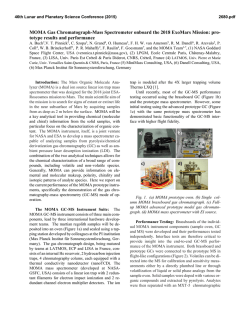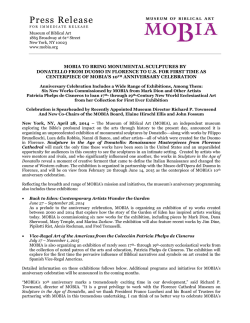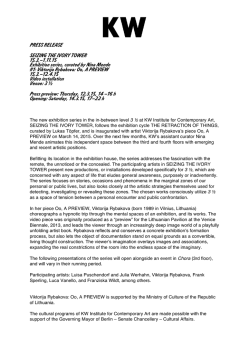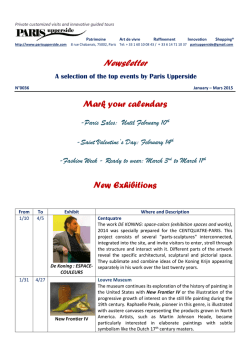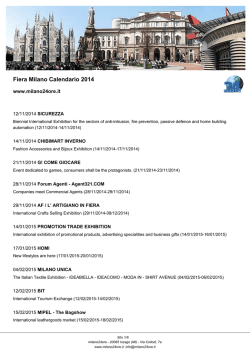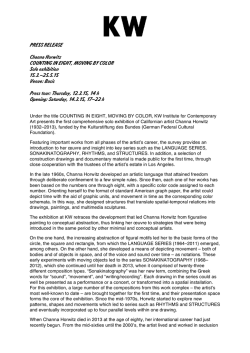
Press Release - MoMA Online Press Office
MoMA RETROSPECTIVE OF THE SINGER, COMPOSER, AND MUSICIAN BJÖRK CHRONICLES OVER TWO DECADES OF HER DARING AND INNOVATIVE MUSIC, VIDEOS, VISUALS, OBJECTS, COSTUMES, AND INSTRUMENTS Björk Includes a New Immersive Music and Film Experience Conceived and Realized by Björk with Andrew Thomas Huang and Commissioned for the Exhibition by MoMA Björk March 8–June 7, 2015 The Donald B. and Catherine C. Marron Atrium, second floor The Agnes Gund Garden Lobby and main Museum Lobby, first floor Press Preview: Tuesday, March 3, 2015 NEW YORK, February 2, 2015—MoMA presents Björk, a retrospective dedicated to the multifaceted work of the singer, composer, and musician, from March 8 to June 7, 2015. Björk offers an experience of music in many layers, with instruments, a theatrical presentation, an immersive sound experience, a focused audio guide, and related visualizations—from photography and music videos to new media works. The exhibition draws from more than 20 years of the artist’s daring and innovative career, beginning with her eight full-length albums and multiple collaborations with directors, photographers, designers, artists, and other experimental practitioners, and culminating in a new, immersive music and film experience commissioned by MoMA. The exhibition is conceived and organized by Klaus Biesenbach, Chief Curator at Large at MoMA and Director of MoMA PS1, and is made possible by a partnership with Volkswagen of America. The product of a close collaboration between Mr. Biesenbach and Björk, the exhibition brings together a chronology of sounds, videos, objects, instruments, costumes, and images that express the artist’s overarching project: her music. Chronologically, the exhibition begins with the release of Björk’s first mature solo album, Debut, in 1993, and proceeds through her career up to her most recent work in 2015, including a new video and music installation commissioned especially for the Museum, Black Lake (which also appears on her new album, Vulnicura). Mr. Biesenbach states: “An uncompromisingly original and highly accomplished auteur and solo artist in her composing, singing, and music, Björk is notably open to collaboration and interpretation of her work, extending even into education and audience participation. Over the decades she has also developed a highly collaborative practice to visualize and express her music and lyrics. Working with photographers, film- and video-makers, designers, architects, craftsmen, and inventors, she crosses over into all categories of high and low culture, digital and analog, into most creative fields.” The retrospective is composed of multiple layers, within the Museum lobbies on the first floor and the Donald B. and Catherine C. Marron Atrium on the second floor. In the lobbies, four musical instruments from Biophilia are on view, programmed to play music and sounds composed by Björk. The instruments include a Tesla coil, Gravity Harps designed by Andrew Cavatorta, a gameleste, an instrument that is a combination of a gamelan and a celesta, made by Björgvin Tómasson and Matt Nolan, and a pipe organ, also designed by Tómasson. Björk’s integration of music, design, and digital technology is consistently groundbreaking, and the Biophilia app, acquired by MoMA’s Department of Architecture and Design, is the first app to enter the collection. The Biophilia app is on view in the third-floor Architecture and Design galleries. In the Marron Atrium, a two-story structure is specifically built for the exhibition’s acoustical needs. An experimental sound experience with Björk’s music and a fictitiously biographical narrative, written by Icelandic writer Sjón, was developed in partnership with Volkswagen’s Electronics Research Lab in Belmont, CA. This interactive location based system will provide visitors an intimate audio experience on the upper level of the structure, which was conceived by the curator in close collaboration with the artist and her consultants Sam Gainsbury and Gideon Ponte from Gainsbury and Whiting. The exhibition chronicles the last 22 years of Björk’s exemplary body of work through her eight albums: Debut (1993), Post (1995), Homogenic (1997), Vespertine (2001), Medulla (2004), Volta (2007), Biophilia (2011), and Vulnicura (2015). For each album a complex, multifaceted character was created, represented through striking visual images that express and embody her music. Among the many visuals, objects, and costumes on view are the robots designed by Chris Cunningham for the music video All Is Full of Love; Marjan Pejowski’s Swan Dress (2001); Alexander McQueen’s Bell Dress (2004) and Pagan Poetry Dress (2001); Iceland Love Corporation’s Volta album costume (2007); Bernhard Willhelm’s Volta tour dress (2007); Hussein Chalayan’s Airmail Dress (1999); Iris van Herpen’s Biophilia tour dress (2013); and Maiko Takeda’s Atmospheric Reentry headpiece from 2013, among others. On the lower level of the Marron Atrium structure, Björk’s newest character and album will be featured in an immersive music and film experience, Black Lake. The 10-minute video, conceived and realized with director Andrew Thomas Huang, was filmed on location in Iceland during the summer of 2014, and includes motifs from the Icelandic landscape—caves, ravines, lava, and moss fields—and reflects ideas of pain, perishing, and rebirth. Black Lake was realized in collaboration with the 3-D design firm Autodesk, who worked along with David Benjamin and The Living on the installation at MoMA. Also on the lower level of the Marron Atrium structure, a generous cinema space will show a chronological presentation of Björk’s music videos. In her music videos Björk has embraced elements of experimental video and filmmaking, technology, narration, and performance to create a rich and varied body of work. Her music videos have become some of the most creative ways for her to visualize each album’s characters, and have also been the site for some of her most fruitful collaborations. For each video she works closely with the director on the concept and execution, and over the course of her career she has often continued these collaborative relationships across 2 multiple projects. Sound design in the cinema and Black Lake was done by Marco Perry for Immersive Audio, Ltd., with the support of Bowers & Wilkins. The exhibition explores Björk’s singular place in contemporary art, and celebrates her highly original and significant music, compositions, performances, and visual presentations. SPONSORSHIP: The exhibition is made possible by a partnership with Volkswagen of America. Special thanks to Autodesk, Bowers & Wilkins, Michael Andrews Audio Visual Services, and Barco. Major support is provided by MoMA’s Wallis Annenberg Fund for Innovation in Contemporary Art through the Annenberg Foundation. Additional funding is provided by The Modern Women’s Fund, The Junior Associates of The Museum of Modern Art, Iceland Naturally, and the MoMA Annual Exhibition Fund. HEARING LOOPS: In order to serve visitors with hearing loss, Björk includes induction hearing loops for sound amplification. Visitors to the installation can turn their hearing aid or cochlear implant to T-Coil mode to hear enhanced sound effortlessly. PUBLICATION: Björk. With contributions by Klaus Biesenbach, Alex Ross, Nicola Dibben, Timothy Morton, and Sjón. Björk is a contemporary icon whose contributions to music, video, film, fashion, and art have influenced a generation worldwide. Designed by top graphic design agency M/M, the publication is composed of six parts: four booklets, a paperback, and a poster, all encased in a slipcase. Each booklet contains illustrated texts by curator Klaus Biesenbach, New Yorker music critic Alex Ross, professor of musicology Nicola Dibben, and philosopher Timothy Morton (in conversation with Björk), while the poster features artwork from Björk’s albums and singles. The main book focuses on her major albums and the personas created for each one. Poetic texts by her longtime collaborator, the Icelandic poet Sjón, are accompanied by shots of Björk performing live; stills from music videos directed by Michel Gondry, Chris Cunningham, and Spike Jonze; images of Björk in costumes by designers such as Alexander McQueen and Hussein Chalayan; and shots by photographers such as Nan Goldin, Juergen Teller, Stéphane Sédnaoui, Inez van Lamsweerde and Vinoodh Matadin, and Araki. Slipcase. Five paperback booklets and a poster. 9 1/2 x 12"; 192 pp.; 224 color ills. 978-0-87070960-9. $65 No. 4 For downloadable high-resolution images, register at MoMA.org/press. Press Contacts: Paul Jackson, (212) 708-9593 or [email protected] Margaret Doyle, (212) 408-6400 or [email protected] ************************* Public Information: The Museum of Modern Art, 11 West 53 Street, New York, NY 10019, (212) 708-9400, MoMA.org. Hours: Saturday through Thursday, 10:30 a.m.–5:30 p.m. Friday, 10:30 a.m.–8:00 p.m. Museum Admission: $25 adults; $18 seniors, 65 years and over with I.D.; $14 full-time students with current I.D. Free, members and children 16 and under. (Includes admittance to Museum galleries and film programs). Free admission during Uniqlo Free Friday Nights: Fridays, 4:00–8:00 p.m. MoMA.org: No service charge for tickets ordered on MoMA.org. Tickets purchased online may be printed out and presented at the Museum without waiting in line. (Includes admittance to Museum galleries and film programs). 3
© Copyright 2025
